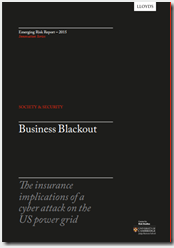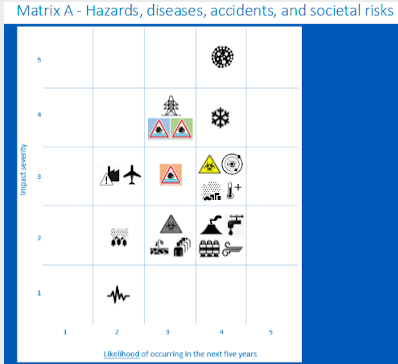 |
| Link |
Note: September is National Preparedness Month . Follow this year’s campaign on Twitter by searching for the #NatlPrep hash tag.
This month, I’ll be rerunning some edited and updated older preparedness essays, along with some new ones.
#13,521
With hundreds of thousands of people in the Carolinas currently without power due to Hurricane Florence - and the memory still fresh of last year's triple assault by hurricanes Harvey, Irma, and Maria that left millions in the dark for weeks or even months - today seems like a good day to look back at The Lloyd’s Business Blackout Scenario from 2015.
For our modern, tech dependent society - in terms of both economic and societal impact - very little beats a prolonged and widespread power outage.Localized outages, such as we're seeing in the wake of Hurricane Florence, can be terribly disruptive, but outside help (mutual aid) is generally available from nearby sources. Larger outbreaks - or those that involve a massive loss of infrastructure - are much tougher to deal with.
Unlike air, water, shelter, or food . . . we don't actually need electricity to survive. But we've built our society, and everything that goes with it, on the expectation of always having electrical power at the flick of a switch.
Without electrical power, water and gasoline doesn’t pump, elevators and air conditioners don’t run, ATM machines and banks close, grocery stores can’t take debit or credit cards, produce, meat and frozen foods spoil, and doing everything - from cooking, to communications, to flushing toilets - becomes difficult or impossible.Small wonder that many countries view the integrity and continued output from their electrical grid a national security issue, and consider threats against it to be among their biggest challenges.
The U.S. isn't alone in these concerns. Every couple of years the UK reassesses their threat landscape, and releases an updated CIVIL RISKS REGISTER. Last fall they published a new update, putting a pandemic, followed by major `grid down' event at the top of their list of greatest concerns (see below).
Just over 5 months ago, the UK released an updated National Security Capability Review (NSCR) which (among other things) emphasized the greatest threats they see facing the UK over the next 5 years.
Diseases and natural hazards affecting the UK.
One or more major hazards can be expected to materialise in the UK in every five year period. The most serious are pandemic influenza, national blackout and severe flooding. We published the latest edition of the National Risk Register of Civil Emergencies in September 2017. It provides an assessment of the likelihood and potential impact of a range of different civil emergency risks that may directly affect the UK over the next five years.Also of great concern, every four years the ASCE (American Society of Civil Engineers) releases a report card on America’s infrastructure, and their most recent report (2017) warns that our cumulative GPA for infrastructure sits at only a D+, and two of our most vulnerable infrastructures are drinking water and the electrical grid (see When Our Modern Infrastructure Fails).
While hurricanes and aging infrastructure are legitimate concerns, other events - such as large earthquakes, tsunamis, cyber attacks or solar storms must also be considered.Few people realize how close we came to a grid down disaster six years ago (see NASA: The Solar Super Storm Of 2012). Last September, another major X-flare erupted just after it had passed around the limb of the sun, missing earth by only a few days (see USGS: Preparing The Nation For Severe Space Weather).
In 2014 a study was published suggesting the odds of earth being struck by one of these solar super storms is actually a lot higher than we’ve previously thought. From a NASA article:
In February 2014, physicist Pete Riley of Predictive Science Inc. published a paper in Space Weather entitled "On the probability of occurrence of extreme space weather events." In it, he analyzed records of solar storms going back 50+ years. By extrapolating the frequency of ordinary storms to the extreme, he calculated the odds that a Carrington-class storm would hit Earth in the next ten years.Unlike most of the scenarios previously discussed, a Carrington-class CME could take out the electrical grid on a hemispheric - perhaps even global - scale. There would be little or no `mutual aid' as just about everyone would be in the dark, and recovery could take years.
The answer: 12%.
The grid can also be taken down by more nefarious means, a topic explored by well known journalist Ted Koppel in his 2015 book called Lights Out: A Cyberattack, A Nation Unprepared, Surviving the Aftermath.
There are hours of interviews with Ted Koppel about his book on YouTube, including with PBS, Charlie Rose, and the following hour long discussion with the National Press Foundation.Despite congressional committees and national GridEx preparedness drills - a recent Congressional Research Service report warns that the US power grid remains vulnerable to attack.
Just over a year ago, in DHS: NIAC Cyber Threat Report - August 2017, we looked at a 45 page report addressing urgent cyber threats to our critical infrastructure that called for `bold, decisive actions'.Three years ago Lloyds, perhaps the most recognizable name in insurance and risk analysis around the world - in collaboration with the University of Cambridge Centre for Risk Studies – published a 68 page analysis of a fictional but plausible cyber attack on the United States power grid called Business Blackout: The insurance implications of a cyber attack on the US power grid.
From their press release New Lloyd’s study highlights wide ranging implications of cyber attacks.
Wed 08 Jul 2015Although plausible, and certainly chilling, a cyber attack isn’t inevitable. But hurricanes, and earthquakes, and even solar storms . . . are. Admittedly, the average person can't do much about the vulnerabilities of our national infrastructure.
Lloyd’s and the University of Cambridge’s Centre for Risk Studies are today launching a new report, Business Blackout. This joint report is the first to examine the insurance implications of a major cyber attack, using the US power grid as an example.
The report depicts a scenario where hackers shut down parts of the US power grid, plunging 15 US states and Washington DC into darkness and leaves 93 million people without power. Experts predict it would result in a rise in mortality rates as health and safety systems fail; a decline in trade as ports shut down; disruption to water supplies as electric pumps fail and chaos to transport networks as infrastructure collapses.
The total impact to the US economy is estimated at $243 billion, rising to more than $1 trillion in the most extreme version of the scenario. The cyber attack scenario shows the broad range of claims that could be triggered by disruption to the US power grid, with total amount of claims paid by the insurance industry estimated at $21.4 billion, rising to $71.1 billion in the most extreme version of the scenario.
(Continue . . . )
But we can - as individuals, families, and businesses owners - increase our preparedness and resilience, which will in turn reduce our burden on local governments and relief agencies, while making our lives easier for the duration.So . . . if a disaster struck your region today, and the power went out, stores closed their doors, and water stopped flowing from your kitchen tap for the next 7 days . . . do you already have:
- A battery operated NWS Emergency Radio to find out what was going on, and to get vital instructions from emergency officials
- A decent first-aid kit, so that you can treat injuries
- Enough non-perishable food and water on hand to feed and hydrate your family (including pets) for the duration
- A way to provide light when the grid is down.
- A way to cook safely without electricity
- A way to purify or filter water
- A way to stay cool (fans) or warm when the power is out.
- A small supply of cash to use in case credit/debit machines are not working
- An emergency plan, including meeting places, emergency out-of-state contact numbers, a disaster buddy, and in case you must evacuate, a bug-out bag
- Spare supply of essential prescription medicines that you or your family may need
- A way to entertain yourself, or your kids, during a prolonged blackout
